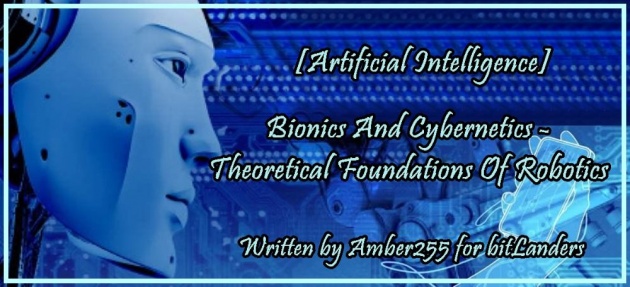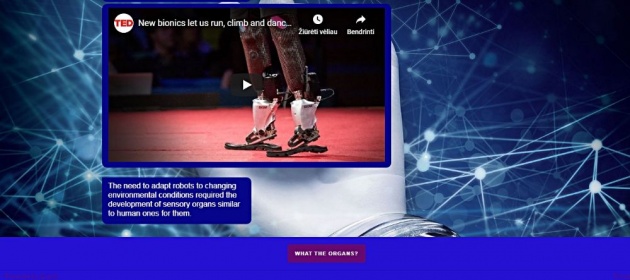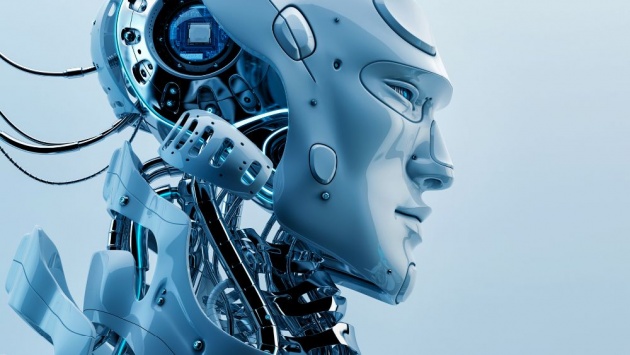
[Artificial Intelligence] Bionics And Cybernetics - Theoretical Foundations Of Robotics - Photo credit: brookings, edition by Amber255 via bitLanders
BIONICS - a section of cybernetics related to the construction of technical devices and systems, as well as to the solution of various engineering problems based on the study of the functioning of organs and systems in living nature.
Bionics is a science that borders between biology and technology, solving engineering problems while analyses the structure and vital activity of organisms.
The idea of applying knowledge of natural life to solve engineering problems belongs to Leonardo da Vinci, who tried to build an aircraft with flapping wings, like a bird ornithopter.
In 1960, Dayton (USA) hosted the first symposium on bionics, which officially secured the birth of new science.
Bionics or biologically inspired engineering is the application of biological methods and systems found in nature to the study and design of engineering systems and modern technology.
Credit: en.wikipedia
The main areas of work on bionics cover the following problems:
- the study of the nervous system of humans and animals and the modeling of nerve cells - neurons - and neural networks to further improve computer technology and develop new elements and devices for automation and neuro bionics;
- the study of the senses and other sensory systems of living organisms in order to develop new sensors and detection systems;
- the study of the principles of orientation, location, and navigation in various animals for the use of these principles in technology;
- study of morphological, physiological, biochemical features of living organisms to put forward new technical and scientific ideas.
Studies of the nervous system have shown that it has a number of important and valuable features and advantages over all the most modern computing devices. These features, the study of which is very important for the further improvement of electronic computing systems.
Cybernetics & Bio Manipulation - Video credit: youtube
Cybernetics
Cybernetics is the science of managing complex feedback systems. It arose at the intersection of mathematics, technology, and neurophysiology, and it is interested in both living and non-living systems, where there was a feedback mechanism.
Cybernetics has combined the most important achievements in the theory of automatic regulation, information theory, and in many sections of other scientific disciplines. The basis of this integration process is the most important and unifying property of control systems - the process of receiving, transmitting, storing, and processing information.
The concept of a “black box” was first formulated in cybernetics as a device that performs a certain operation on the present and past of the input potential, but for which we do not necessarily have information about the structure that ensures this operation is performed.
Cybernetics has identified the foundations of management and allowed to establish common properties in various environments - in nature, society, technology. Knowledge makes it possible to form many processes in these environments, using a powerful mathematical apparatus and computer technology.

[Artificial Intelligence] Bionics And Cybernetics - Theoretical Foundations Of Robotics - Photo credit: querlo
There are many wise definitions of cybernetics as a science. It is permissible to give one more thing: cybernetics studies the issues of management, communication, control and regulation, reception, storage and processing of information in any complex dynamic system. If in any complex breakdown system, be it a technological line, animal, person or society, the processes of receiving, processing, storing and issuing information occur, then this system falls under the laws of cybernetics.
Without the use of cybernetics methods, many of the latest achievements of human thought would have been fundamentally impossible: space exploration, control of particularly complex technological processes that are fast-moving in time or dangerous to human life.
Over the past 30 years, cybernetics has gone through ups and downs, becoming more and more significant in the field of the study of artificial intelligence and biological machine interfaces, that is, cyborgs.
Check my newest Querlo chat to get more info about:
1. Bionics - the core of robotics 2. Bionic robotics:
a) Bionic robots; b) Bionic prostheses; 3) Bionic Robot Components.
4. What is cybernetics? 5. Human-machines 6. Future of Bio-cybernetics
Please, chat with me about Bionics And Cybernetics (the link opens chat in a full-screen mode):
Bio-cybernetics
Over the past 30 years, cybernetics has gone through ups and downs, becoming more and more significant in the field of the study of artificial intelligence and biological machine interfaces, that is, cyborgs.
On A Final Note
By the end of the 60s of our century, the science and technology had achieved considerable success, and technical cybernetics, various automatic control systems, special sections of mathematics, bionics, and much more appeared. All this made it possible to develop complex robots with artificial intelligence, the ability to adapt to the environment, and self-learning.
The creators of modern robots just strive to give the robot all of these qualities, using all the available achievements in various fields of science, technology, using various technologies, the latest achievements, and ideas. But, ultimately, when building a robot as a complex system, the main ideas are borrowed from nature, and their implementation is the work of the modern man and his achievements.

[Artificial Intelligence] Bionics And Cybernetics - Theoretical Foundations Of Robotics - Photo credit: it-wire
Nature and the man himself has not been fully studied by us, so it’s still very early to talk about creating an ultramodern robot, although neurocybernetics offers completely amazing solutions to some problems.
The main task of bio-cybernetics is to study the various systems of living organisms to build complex technical systems, that is, artificial intelligence. Here is one of the tasks that bio-cybernetics solves - the creation of neurocomputers with an unusual architecture consisting of a neural network that replaces the processor, memory, etc., combining all the functions of these electronic computer devices.
************************************************************************
****************************************************************
****************************************
I invite you to participate in Bitlanders AI-themed Blogging and create your own AI-themed blogs and C-blogs on artificial intelligence theme:
bitLanders AI-themed blogging
After the successful launch of "The bitLanders C-blogging", conversational AI blogging by Querlo powered by IBM Watson and Microsoft Azure. bitLanders continues to support its joint venture Querlo. We believe in our mission to promote our future - Artificial Intelligence (AI) - and build AI conversations via blogging, here we are to introduce "bitLanders AI-themed blogging!"Credit: quote from bitLanders
Always welcome back to check more Querlo Chat blogs on Artificial Intelligence theme.
***************************************************************************************************
Thank you for stopping by and reading my blog.
2019, All Rights Reserved.
You are very welcome to join Bitlanders and share your valuable knowledge and opinion.
***************************************************************************************************



